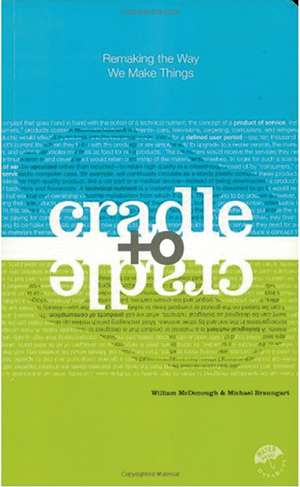Cradle to Cradle
Autor William McDonough, Michael Braungarten Limba Engleză Paperback – 31 mai 2003
"Reduce, reuse, recycle" urge environmentalists; in other words, do more with less in order to minimize damage. As William McDonough and Michael Braungart argue in their provocative, visionary book, however, this approach perpetuates a one-way, "cradle to grave" manufacturing model that dates to the Industrial Revolution and casts off as much as 90 percent of the materials it uses as waste, much of it toxic. Why not challenge the notion that human industry must inevitably damage the natural world, they ask.
In fact, why not take nature itself as our model? A tree produces thousands of blossoms in order to create another tree, yet we do not consider its abundance wasteful but safe, beautiful, and highly effective; hence, "waste equals food" is the first principle the book sets forth. Products might be designed so that, after their useful life, they provide nourishment for something new-either as "biological nutrients" that safely re-enter the environment or as "technical nutrients" that circulate within closed-loop industrial cycles, without being "downcycled" into low-grade uses (as most "recyclables" now are).
Elaborating their principles from experience (re)designing everything from carpeting to corporate campuses, the authors make an exciting and viable case for change.
| Toate formatele și edițiile | Preț | Express |
|---|---|---|
| Paperback (2) | 51.92 lei 24-35 zile | +17.01 lei 7-11 zile |
| Random House – 29 ian 2009 | 51.92 lei 24-35 zile | +17.01 lei 7-11 zile |
| North Point Press – 31 mai 2003 | 209.02 lei 3-5 săpt. | +50.85 lei 7-11 zile |
Preț: 209.02 lei
Nou
39.99€ • 41.76$ • 33.03£
Carte disponibilă
Livrare economică 25 martie-08 aprilie
Livrare express 11-15 martie pentru 60.84 lei
Specificații
ISBN-10: 0865475873
Pagini: 208
Dimensiuni: 131 x 200 x 17 mm
Greutate: 0.55 kg
Ediția:1
Editura: North Point Press
Locul publicării:United States
Notă biografică
Michael Braungart is a chemist and the founder of the Environmental Protection Encouragement Agency (EPEA) in Hamburg, Germany. Prior to starting EPEA, he was the director of the chemistry section for Greenpeace. Since 1984 he has been lecturing at universities, businesses, and institutions around the world on critical new concepts for ecological chemistry and materials flow management. Dr. Braungart is the recipient of numerous honors, awards, and fellowships from the Heinz Endowment, the W. Alton Jones Foundation, and other organizations.
In 1995 the authors created McDonough Braungart Design Chemistry, a product and systems development firm assisting client companies in implementing their unique sustaining design protocol. Their clients include Ford Motor Company, Nike, Herman Miller, BASF, DesignTex, Pendleton, Volvo, and the city of Chicago. The company's Web site can be found at www.mbdc.com.
Descriere
'Reduce, reuse, recycle' urge environmentalists; in other words, do more with less in order to minimize damage. But as architect William McDonough and chemist Michael Braungart point out in this provocative, visionary book, this approach only perpetuates the one-way, 'cradle to grave' manufacturing model, dating to the Industrial Revolution, that creates such fantastic amounts of waste and pollution in the first place. Why not challenge the belief that human industry must damage the natural world? In fact, why not take nature itself as our model for making things? A tree produces thousands of blossoms in order to create another tree, yet we consider its abundance not wasteful but safe, beautiful and highly effective.
Waste equals food.
Guided by this principle, McDonough and Braungart explain how products can be designed from the outset so that, after their useful lives, they will provide nourishment for something new - continually circulating as pure and viable materials within a 'cradle to cradle' model. Drawing on their experience in redesigning everything from carpeting to corporate campuses, McDonough and Braungart make an exciting and viable case for putting eco-effectiveness into practice, and show how anyone involved in making anything can begin to do so as well.
















